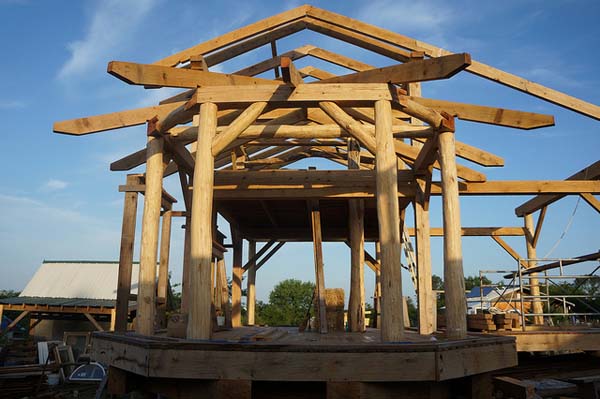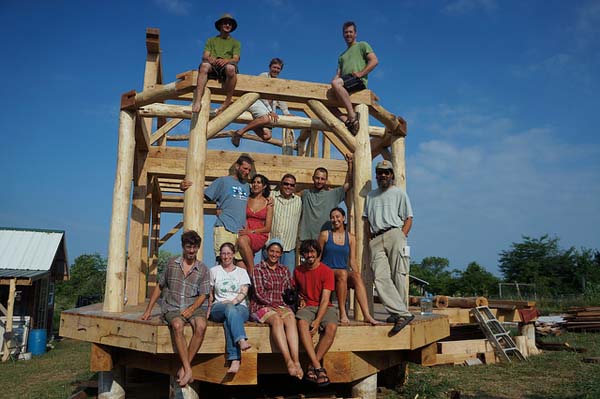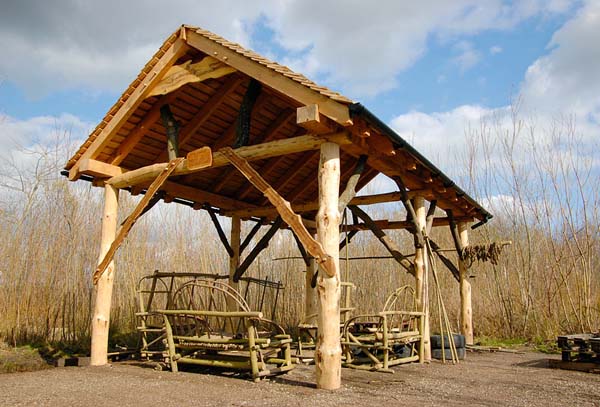Dimensional lumber — 2x4s, 2x6s, etc., are about as ubiquitous as suburban sprawl is in America. (Maybe there’s some kind of relationship there..?) 2x4s are an industrial product, only becoming a dominant building material in the last century. As priorities have shifted to speed, uniformity, and ease of production, more traditional building styles have fallen out of favor.
However, it is almost certainly time to rethink how we build our homes, addressing not only downsizing possibilities, and the size and efficiency of spaces, but how we build houses themselves, and what materials we use. I believe timber framing, and specifically roundwood timber framing, fills a great need, enabling more holistic and sustainable home construction.
Building Locally?
Here’s a great passage from the USDA Forest Service’s “History of Yard Lumber Size Standards” (warning: PDF link) that hints at industrialization beginning to seep into the world of construction:
Until the middle of the 19th Century, building lumber was usually produced in a locality close to the place where it was to be used. Sizes were not a problem. The needs of builders in the locality were well understood and carpenters were accustomed to much more hand fitting on the job than they are today. As the forests were cut back from the centers of population, lumber had to be shipped greater distances. By the last few decades before 1900, lumber was no longer a locally made commodity. It then became apparent that the sizes used in different trading areas were not uniform and as a result sawmills had to cut lumber for the markets they wished to serve.

Like food, perhaps we should take the local approach and build with locally available materials, reducing the impacts of transportation, improving local economies, and gaining a greater sense of connection to the source of materials.
Timber framing, the technique of using large posts and beams, joined with mortises and tenons and later pegged, and without the use of any metal fasteners, is an ancient and proven technique that is particularly well-suited to using local wood. Due to their sheer size and weight, large timbers are not practical to ship, and are generally transported only short distances. Much of the US has some suitable wood for timber framing, especially roundwood timber framing.
Roundwood Timber Framing Advantages
To produce an 8×8 or 8×10 square timber, there is some amount of waste in the milling process. However, by using trees in the round, there is no waste to speak of. In fact, smaller diameter timbers can be used in building, because roundwood is 50% stronger than similar-sized squared timber.

That means less wood, and less waste is necessary for construction. Combined with forestry coppicing techniques, trees can be thinned at a certain time of year, and the stump will send new shoots up, which will mature and can be harvested all over again years later. Forests can be managed to grow timber specifically for building, as seen in the work of Ben Law in the UK. There are a number of tree species suitable for this practice, including black locust, which has a very wide range of growing conditions.
Roundwood: Local, Durable, Beautiful
Other benefits of timber framing, and roundwood timber framing include durability, strength, and beauty. Stick framing is not a construction method known for lasting hundreds of years. However, there are timber frame homes still being occupied 500 years after their construction.
Timber frames are incredibly durable and strong, withstanding both time and severe climate conditions much more respectably than stick buildings. Using organic round posts and beams brings us closer to the source of the material, as well, and enables more creative and inviting living environments.
To learn more about timber frame construction, check out this Timber Frame Workshop at Dancing Rabbit Ecovillage in Missouri this August, where participants will get hands-on experience working with roundwood and building a house using local and reclaimed materials.


A really different way of thinking about wood! Thanks for this, and the beauty of this sort of construction shown here.
Very interesting post. I am lucky to live in SE Texas where lumber is milled locally. There is a custom mill about 8 miles from where I am building my structure that specializes in cedar. I expect to use that mill for my interior and exterior. I have never considered using round timber for building, though perhaps with a bit more study I can attempt. I am lucky to have an 80 acre property full of Cedar and Oaks so I will investigate.
Ed,
Texas cedar makes for a beautiful and unique cabin project. Go for it. Upload the pics of your project.